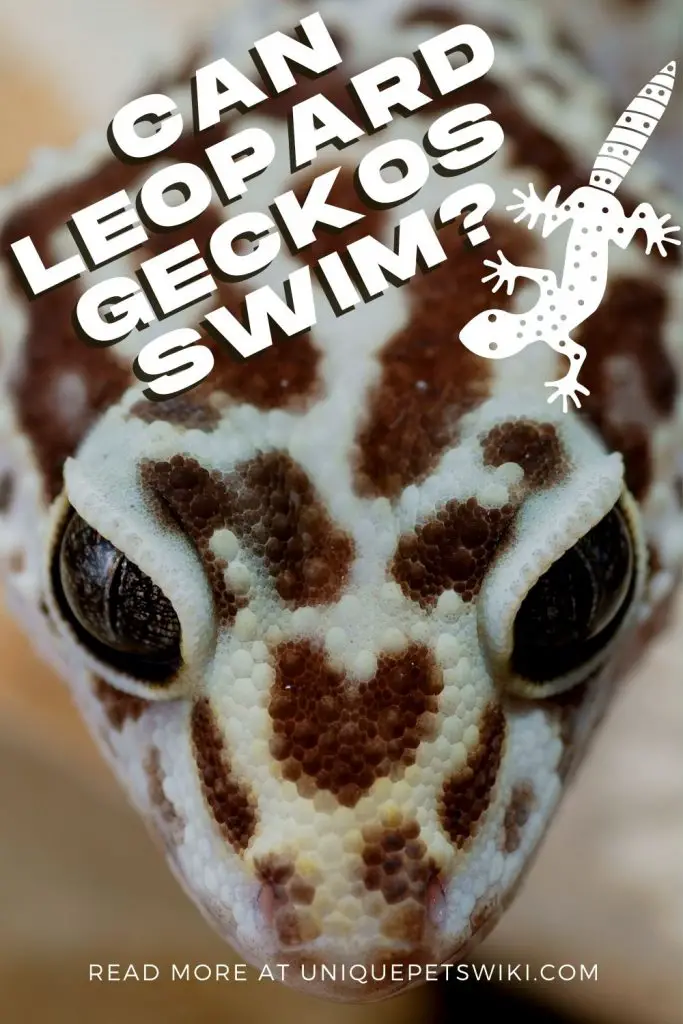You may be thinking of getting a bathe for your leopard geckos. However, you do not know if can leopard geckos swim or they can drown?
I am glad to tell you that leopard geckos are able to do kind of swimming. That means, they can “survive” when bathing.
Before you get excited, you should also know that they do not like swimming. To leopard geckos, swimming is something they do as a necessity rather than enjoyment. It is an essential survival skill that is in them, but they use it sparingly.
Sorry to burst your bubble!! In this article, you will learn more about how leopard geckos can swim, what other geckos can swim, whether you can force your gecko to swim, and so on.
Let’s dive right into it.
Contents
- Can Leopard Geckos Swim? The Ability Of Leopard Geckos To Swim
- How Do Leopard Geckos Swim?
- Can I Force My Leopard Gecko To Swim?
- Can All Geckos Swim?
- What Other Geckos Shouldn’t Be Forced To Swim?
- Tips For Bathing A Leopard Gecko Without Harming Them
- How Often Can I Give My Leopard Gecko A Bath?
- Giving Leopard Gecko Impaction Bath
- Giving Leopard Gecko Sugar Bath
- Wrapping Up
Can Leopard Geckos Swim? The Ability Of Leopard Geckos To Swim

To address your curiosity about can your leopard geckos to swim or not. The simple answer is: leopard geckos cannot but swim but float on water. You should avoid letting them swim due to the high drowning risk. Furthermore, leopard geckos get stressed when in water and can lead to other health issues for your gecko.
Being in the family of a lizard, leopard geckos can swim as a form of instinct. When a leopard gecko is in danger and close to a pool, it will naturally jump in it to escape from the predator.
Furthermore, leopard geckos will have to hold their breath underwater because they do not possess gill. However, you will not find leopard geckos dive into water frequently. Instead, they prefer to stay afloat while swimming ashore.
They will then hold their breath underwater when it is not possible to stay afloat. However, leopard geckos cannot hold their breath for a long time. This means they can drown if they are not able to get above the water very quickly.
How Do Leopard Geckos Swim?

It is never the intention of leopard geckos to swim, and they usually swim like they are walking on land. Leopard geckos will use their tail for propelling themselves. Luckily, they have a hydrophobic skin which can resist water and helps them in staying afloat.
However, you may think they are an excellent swimmer if you spot a leopard gecko swimming. I will say that leopard geckos are simply an instinctive swimmer that will only swim when in danger.
Can I Force My Leopard Gecko To Swim?

Since leopard geckos are not an aquatic reptile, it is wrong to force them to swim. Leopard geckos hate swimming, and it can lead to stress and bad experience for them.
Some of the things that can happen if you force your leopard gecko to swim are:
- Your gecko will see you as a threat. If you force them to swim, it will make them fear you, and it will be hard to bond with your leopard gecko.
- It can lead to stress. From instinct, leopard geckos will swim only when threatened, forcing them to do it will scare them and will lead to stress.
- It can even lead to death. By forcing your gecko to swim, they may drown while swimming.
From the reasons stated above, it is wrong and unethical to force your gecko to swim. You will not only be causing your gecko stress; they will see you as a threat.
Can All Geckos Swim?
You may be curious to know if all geckos can swim. All geckos can swim, but they don’t love swimming. Swimming is a natural survival skill that they use when necessary but not for enjoyment.
You will also be surprised to hear that geckos can run on water to get away from predators.
What Other Geckos Shouldn’t Be Forced To Swim?

Crested Geckos
Like leopard geckos, swimming can be a bad experience for crested geckos, leading to stress. Crested geckos only swim when under attack, not for enjoyment.
Although it may look like a good idea to force your cresties to swim, you should avoid putting them in this situation. Crested geckos can even drown in a pool of water if they stay underwater for a long time.
However, there are times when crested geckos soak themselves in water to aid their shedding process. You can mist them with water or provide them with a small dish of water to soak in when they are shedding.
The White-Lined Gecko
This is another popular reptile pet that will never swim voluntarily. However, when it finds itself in a pool of water, it will run through the water to go ashore and save its life.
You should avoid forcing or teaching your white lined gecko to swim.
Madagascar Day Gecko
This gecko will also swim instinctively, and the experience can be traumatizing for them. Madagascar day gecko panic once they hit the water and find it hard to move through the water. As a responsible Madagascar day gecko owner, ensure you should not force them to swim.
Furthermore, you should avoid putting a water bowl in the cage. All you need to do is ensure that their tank has a high level of humidity.
Gargoyle Gecko
Gargoyle geckos are not aquatic reptiles, and you should not assume that you can force them to swim. Although you can bathe them during their shedding period to make the process easier. You should avoid putting them in water regularly.
The Frog Eyed Gecko
Just like other geckos on the list, frog eyed geckos should not be forced to swim. However, you can place a small bowl of water in their tank.
Note: All the geckos mentioned above cannot swim; they can drown rather than swimming to a safe spot. Thus, when keeping a gecko, you can look for another way to entertain them rather than make them swim.
Tips For Bathing A Leopard Gecko Without Harming Them
Leopard geckos originate from a dry environment, and you don’t really need to bathe them. Leopard geckos do not enjoy bathing because they can dry their skin and drown in deep water.
Some of the reason why you can bathe your leopard geckos are
- If your leopard gecko gets dirty
- To help it with constipation or prolapsed hemipenis
- To help when they have stuck or problematic shedding.
Note: Apart from the reasons above, it is best if you do not bathe your leopard gecko for enjoyment or any other reasons. Furthermore, you need to avoid soaking young leopard geckos until they are around 4-5months old. This is because you need them to be tamed and confident.
Source: https://www.wikihow.com/Bathe-a-Leopard-Gecko
How Often Can I Give My Leopard Gecko A Bath?
You can only bathe your leopard gecko when there is a need, such as when they are shedding or when dirty. This can usually be around 1-2 times a month.
Furthermore, you can simply place a moist hide and spray your leopard gecko to aid their shedding process instead of bathing them.
Do Leopard Geckos Like Water?
Leopard geckos hate water and will become stressed out when you place them in a pool. They can also drown if you put them in deep water.
This is why you should avoid filling the tub with too much water when bathing your gecko.
How To Bathe Leopard Gecko?
Here are the steps to take when bathing your leopard geckos:
- The first thing to do is to prepare a shallow container or tub for soaking or bathing your gecko. However, you need to make sure that the container is bigger than your leopard gecko.
- Put a cloth or paper towel on the bottom of the container. This helps to give leopard geckos extra support and make it relax.
- Fill the container with about 0.5 inches of water. This can touch your leopard gecko’s knees or even to their belly. Ensure the water is not higher than that and avoid assuming that your gecko can swim if the water level is high. When the water is too high, your gecko may try to escape, which can cause stress.
- Also, ensure that the temperature of the water is lukewarm but not hot. The ideal temperature is usually around 89-90 degrees Fahrenheit. You should also avoid letting the water get cold during the soaking period.
- Slowly place your leopard gecko in the container with water.
- Allow your leopard gecko to soak for about 5-10 minutes.
- Dry your leopard gecko with a paper towel and return it to its tank before the body temperature starts to drop.
Note: It is best to bathe your leopard geckos after their shedding process to remove any stuck skin. After shedding, you can check around their toes, head, and around their limb for any stuck shed.
Giving Leopard Gecko Impaction Bath
You can bathe your leopard gecko if you notice that it is impacted.
However, you can easily prevent impaction if you do not use any loose substrate in their tank or give them bugs that are larger than your leopard gecko’s eyes width. You can also provide your gecko with a proper heat source to aid food digestion.
Here are the steps that you can use to give your leopard gecko an impaction bath:
- You can prepare the tub using the same method described above
- After preparing the tub, message your gecko belly from the top to the vent (avoid touching the throat).
- Massage your leopard gecko’s belly for about 5 minutes and let it soak for another 5 minutes.
- Repeat this bathe for a few times until your leopard gecko poops.
Giving Leopard Gecko Sugar Bath
There are times when your leopard gecko’s hemipenis may not retract after mating. If you notice that your gecko has prolapsed hemipenis for more than 24 hours, you can give your gecko a sugar bath.
You need to help your gecko with prolapsed hemipenis because their hemipenis can be infected, dry out, and can suffer necrosis.
Steps to prepare a sugar bathe are as follows:
- Use the same step above to prepare their bath. However, you will need to add some sugar in the water and stir until it dissolves.
- Repeat this bathe once a day until the hemipenis retracts.
- You can also apply a little bit of Vaseline on the hemipenis and use a q-tip to massage it back in.
Wrapping Up

Leopard geckos are an instinctive swimmer. However, they will only swim when there is danger and close to a pool. As a responsible leopard gecko owner, it is best not to force them to swim as it can cause stress and even lead to death by drowning.
